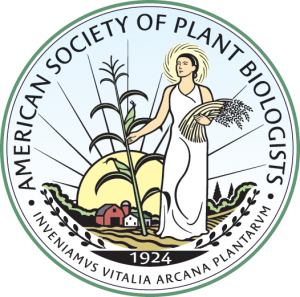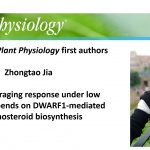Plantae Presents: Graham Farquhar and Ksenia Krasileva
Due to the COVID-19 pandemic many seminar series and conferences have been canceled or postponed. In response to this, and to make sure plant scientists can continue to communicate their latest work to their peers, The American Society of Plant Biologists launched a virtual seminar series via our online community, Plantae. This is the ninth seminar in this new series, each of which features two speakers (read more). A list of upcoming seminars and recorded videos can be found here.
Plantae Presents – Graham Farquhar and Ksenia Krasileva
Recorded Tues June 2nd
Abstract: When plants migrated from the sea to the land, they evolved an impermeable skin to avoid desiccation. However, they also needed carbon dioxide to enter the leaves so that photosynthesis of sugars could take place. This led to the evolution of stomata, small pores in the leaves that allow carbon dioxide to diffuse into the leaf. But because the inside of a leaf is humid, water vapour inevitably diffuses out through the stomata. This leads to a need to compromise between rapid gas exchange that encourages growth and reproduction, and slow exchange that minimizes the dangers of running out of soil water. On a short time scale of, say, a day, this implies an optimum strategy for stomata that amounts to keeping the marginal water cost of carbon gain constant. This requires knowledge of what the rate of water loss (transpiration) would be, and what the rate of photosynthetic carbon dioxide assimilation would be, if stomata had slightly different apertures from the ones they actually have. We predict that the marginal water cost will be greater when the plant feels secure about frequent rainfall in its environment, and less when the water supply is more stochastic. Most of my career has been spent thinking and experimenting with these ideas, and with how to identify plants that are either more adventurous or more conservative. It turns out that this identification can be achieved by measuring the tiny differences in abundance of the heavier stable isotope of carbon in a leaf compared to that in carbon dioxide in the air. The variation in the heavier stable isotope of oxygen in organic matter is also instructive. The question of scale emerges when one tries to imagine the consequences of stomatal opening being different on a whole continent rather than on an isolated leaf. Thus thinking about whether plants are economical in their exchange of water for carbon quickly ramifies into thinking about all sorts of processes on time scales from seconds to those involving climate change and evolution.

Dr. Ksenia Krasileva is an Assistant Professor at the University of California, Berkeley. She is an interdisciplinary scientist who studies genomics and plant immunity. Krasileva holds both BS and PhD degrees from Berkeley where she studied plant-microbe interactions and was trained in Genomic and Computational Biology. She did her postdoctoral work in wheat genomics with Jorge Dubcovsky at University of California Davis where, supported by USDA NIFA Postdoctoral Fellowship, she led the development of wheat exome capture and wheat functional genomics. Before moving back to Berkeley, Krasileva started her own group in 2014 at Earlham Institute and The Sainsbury Laboratory in Norwich, U.K. For her contributions to wheat genomics, Krasileva received the Carlotta award. Krasileva Lab at Berkeley maintains research interests in the biology of genomes, evolution and function of plant innate immunity. @kseniakrasileva
Abstract:
Plant immunity depends either on the direct perception of pathogen molecules or of the changes they induce in the host cells. Both recognition modes require mechanisms for generating diversity in the plant immune receptors. The NLR immune receptors are common to both mammalian and plant innate immunity. How can plants generate sufficient diversity to allow pathogen recognition in the absence of adaptive immunity remains poorly understood. We have previously demonstrated that grasses deploy a specialist intracellular NLR immune receptor clade that undergoes continuous gene fusions incorporating protein domains not normally associated with the immune function. The newly integrated domains in these NLR-ID receptors serve as baits for the pathogen – their modification triggers immune signaling. Such deployment of other plant proteins as baits allows plant immunity to monitor changes that pathogens induce inside the host cell. Our current work addresses the sources of new receptor specificities in the direct recognition of pathogen-derived effectors. We show that a quarter of NLR immune receptors in the model plant A. thaliana evolve much faster than the rest with changes concentrated in the leucine-rich repeat domain. These genes show strong overlap with the hybrid incompatibility loci, suggesting that generation of new immune specificities comes at a cost of autoimmunity. While separated in sequence, the most variable residues cluster on the concave surface of the LRR, allowing prediction of putative effector-binding sites, which we are currently testing in the lab. Together, our analyses uncover distinct mechanisms of diversity generation among different groups of plant NLR receptors.
 Moderator: Caitlin Byrt
Moderator: Caitlin Byrt
Dr. Caitlin Byrt is a research group leader within the Division of Plant Science at the Australian National University. Caitlin studies mechanisms in plants that influence environmental stress tolerance, such as salinity and drought tolerance. Her current research focus is on investigating the physiological roles of specific subsets of a type of membrane intrinsic protein in plants called aquaporins, which influence water, salt and nutrient transport. Her team are working on characterizing subsets of aquaporins in plants that can switch between functioning as water channels and ion channels. They have recently identified key regulatory factors controlling this switch in function. These findings open up new opportunities to test the physiological roles of aquaporin ion transport in plants.
This webinar is freely available thanks to the support of the American Society of Plant Biologists. Join Today.

If you would like to sponsor an upcoming webinar please contact [email protected]






Leave a Reply
Want to join the discussion?Feel free to contribute!